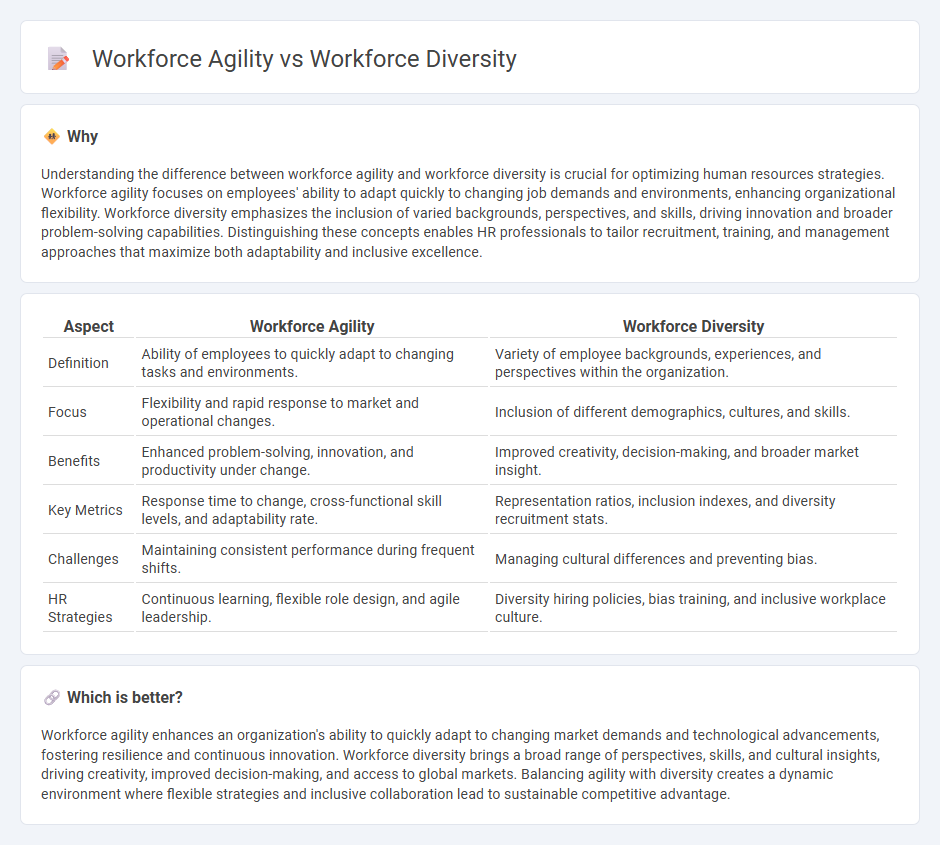
Workforce agility enhances an organization's ability to rapidly adapt to changing market demands, emphasizing flexibility and continuous skill development among employees. Workforce diversity brings varied perspectives, experiences, and cultural backgrounds, driving innovation and more inclusive decision-making. Explore how balancing agility and diversity can optimize human resource strategies for sustainable growth.
Why it is important
Understanding the difference between workforce agility and workforce diversity is crucial for optimizing human resources strategies. Workforce agility focuses on employees' ability to adapt quickly to changing job demands and environments, enhancing organizational flexibility. Workforce diversity emphasizes the inclusion of varied backgrounds, perspectives, and skills, driving innovation and broader problem-solving capabilities. Distinguishing these concepts enables HR professionals to tailor recruitment, training, and management approaches that maximize both adaptability and inclusive excellence.
Comparison Table
| Aspect | Workforce Agility | Workforce Diversity |
|---|---|---|
| Definition | Ability of employees to quickly adapt to changing tasks and environments. | Variety of employee backgrounds, experiences, and perspectives within the organization. |
| Focus | Flexibility and rapid response to market and operational changes. | Inclusion of different demographics, cultures, and skills. |
| Benefits | Enhanced problem-solving, innovation, and productivity under change. | Improved creativity, decision-making, and broader market insight. |
| Key Metrics | Response time to change, cross-functional skill levels, and adaptability rate. | Representation ratios, inclusion indexes, and diversity recruitment stats. |
| Challenges | Maintaining consistent performance during frequent shifts. | Managing cultural differences and preventing bias. |
| HR Strategies | Continuous learning, flexible role design, and agile leadership. | Diversity hiring policies, bias training, and inclusive workplace culture. |
Which is better?
Workforce agility enhances an organization's ability to quickly adapt to changing market demands and technological advancements, fostering resilience and continuous innovation. Workforce diversity brings a broad range of perspectives, skills, and cultural insights, driving creativity, improved decision-making, and access to global markets. Balancing agility with diversity creates a dynamic environment where flexible strategies and inclusive collaboration lead to sustainable competitive advantage.
Connection
Workforce agility enhances the ability of diverse teams to quickly adapt to changing market demands and foster innovation through varied perspectives. Diversity in human resources brings a breadth of skills, experiences, and cultural insights that drive agile decision-making and problem-solving. Combining workforce agility with diversity leads to increased organizational resilience and competitive advantage in dynamic business environments.
Key Terms
Inclusion
Workforce diversity encompasses a broad range of demographic differences, while workforce agility emphasizes the ability of employees to adapt quickly to change; inclusion serves as the critical link that ensures diverse talent feels valued and empowered in an agile environment. Inclusive practices enhance collaboration, innovation, and retention by fostering a sense of belonging among diverse teams, which directly supports agile responses to market shifts. Explore key strategies to integrate inclusion, diversity, and agility for sustainable organizational success.
Adaptability
Workforce diversity enhances adaptability by bringing varied perspectives and problem-solving approaches that enable organizations to respond swiftly to market changes. Workforce agility emphasizes the ability to quickly reconfigure skills and roles to meet evolving demands, fostering a resilient and flexible work environment. Discover how leveraging both diversity and agility can drive superior adaptability in your organization.
Flexibility
Workforce diversity enhances flexibility by incorporating varied perspectives that foster innovative problem-solving and adaptability to changing market demands. Workforce agility emphasizes rapid response and flexibility through continuous learning and dynamic role shifts, enabling organizations to quickly pivot strategies. Explore how blending diversity and agility creates a resilient workforce equipped for future challenges.
Source and External Links
What Is Workforce Diversity? - Types, Importance, & - This article discusses the concept of workforce diversity, including its importance, types, and challenges in creating an inclusive workplace.
Diversity, Equity and Inclusion in the Workplace - This report highlights the views of workers regarding the importance of diversity, equity, and inclusion in the workplace, showing varied perspectives on its significance.
Diversity in the Workplace - This resource discusses the benefits of diversity in the workplace, including improved corporate culture, employee morale, and access to a diverse customer base.
 dowidth.com
dowidth.com